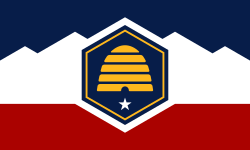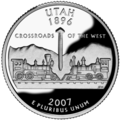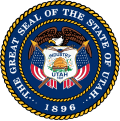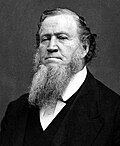Utah
Utah is a state in the west United States. The capital and largest city is Salt Lake City. Utah became a state in the U.S. on January 4, 1896. About 3.3 million people lived there in 2020.
| Utah state symbols | |
|---|---|
 | |
 | |
| Living insignia | |
| Bird | California gull |
| Fish | Bonneville cutthroat trout |
| Flower | Sego lily |
| Grass | Indian ricegrass |
| Mammal | Rocky Mountain Elk |
| Reptile | Gila monster |
| Tree | Quaking aspen |
| Inanimate insignia | |
| Dance | Square dance |
| Dinosaur | Utahraptor |
| Firearm | Browning M1911 |
| Fossil | Allosaurus |
| Gemstone | Topaz |
| Mineral | Copper |
| Tartan | Utah State Centennial Tartan |
| State route marker | |
 | |
| State quarter | |
 Released in 2007 | |
| Lists of United States state symbols | |
In 2018, The top countries of origin for Utah’s immigrants were Mexico (35 percent of immigrants), India (4 percent), Venezuela (4 percent), Peru (4 percent), and Canada (3 percent).[6]
Geography
Utah is bordered by Idaho and Wyoming in the north and Colorado in the east. It touches a single point of New Mexico to the southeast at Four Corners. Utah is bordered by Arizona in the south, and by Nevada in the west. It covers an area of 84,899 square miles (219,887 km²).
Utah is mostly rocky with three distinct geological regions: the Rocky Mountains, the Great Basin, and the Colorado Plateau. Utah is known for its natural diversity and is home to features ranging from arid deserts with sand dunes to thriving pine forests in mountain valleys, which has attracted many tourists.
Climate
Utah has a dry, semi-arid to arid climate,[7] although its many mountains have large, wide, differences of climates, with the highest points in the Uinta Mountains being above the tree line. The dry weather results from the state lying mostly in the rain shadow of the Sierra Nevada in California. The eastern half of the state is in the rain shadow of the Wasatch Mountains. The main source of rain for the state is the Pacific Ocean, with the state normally lying in the path of large Pacific storms from mid-October through April, although northern Utah often sees these large storms earlier and later. In summer, the state, normally southern and eastern Utah, is in the path of monsoon from the Gulf of California. Most of the lowland areas get less than 12 inches (300 mm) of rain a year. The Great Salt Lake Desert is the driest area of the state, with less than 5 inches (125 mm). Snowfall is common in all but the far southern valleys. Although St. George only gets about 3 inches (7.5 cm) per year, Salt Lake City sees about 60 inches (150 cm), enhanced by the lake-effect snow from the Great Salt Lake, which increases snowfall totals to the south, southeast, and east of the lake. Some areas of the Wasatch Range in the path of the lake-effect get up to 700 inches (1,770 cm) per year. The dry, fluffy, snow led Utah's ski industry to get the slogan "the Greatest Snow on Earth" in the 1980s. In the winter, temperature are a phenomenon across Utah's low basins and valleys, leading to thick humidity and fog that can sometimes last for weeks at a time, normally in the Uintah Basin.
Population
The center of population of Utah is in Salt Lake County in the city of "Salt Lake City".[8] As of 2020 the Census Bureau believes Utah has a population of 3,271,616.[9] In 2008, the US Census Bureau determined Utah to be the fastest growing state in the country in terms of population growth.[10]
Much of the population lives in cities and towns along the Wasatch Front, a region that runs north-south with the Wasatch Mountains rising on the eastern side. Growth outside the Wasatch Front is also increasing. The St. George metropolitan area is right now the second-fastest growing in the country after the Las Vegas metropolitan area, while the Heber metropolitan area is also the second-fastest growing in the country (right in front of Palm Coast, Florida).
Economy
The University of Utah says that the gross state product of Utah in 2005 was $92 billion, or 0.74% of the total United States GDP of $12.4 trillion for the same year. The per capital personal income was $24,977 in 2005. Major companies of Utah are: mining, cattle ranching, salt production, and government services.
In eastern Utah petroleum making is a big industry. Near Salt Lake City, petroleum refining is done by a number of oil companies. In central Utah, coal mining accounts for much of the mining activity.
Age and gender
Utah has a high total birth rate, and the youngest population of any U.S. state.
In 2000, the gender percents of Utah were estimated as:
- 49.9 percent female
- 50.1 percent male
Religion
The majority of the state's people are members of the Church of Jesus Christ of Latter-day Saints. These people are called the Mormons or the LDS Church. As of 2020, 60.7 percent of people in the state are members of the Church of Jesus Christ of Latter-day Saints.[11] Mormons are not as common as they used to be in Salt Lake City. Usually, people who live in rural areas in Utah are almost all Mormon. The LDS Church does not support or oppose any political parties,[12] but the church's doctrine is very connected to politics. In the past, many of Utah's lawmakers have been church members. This has contributed to the state's laws on alcohol (sales and content) and gambling. Another effect can be seen in Utah's high birth rate (25 percent higher than the national normal; the highest for a state in the U.S.). The Mormons in Utah normally have conservative views in politics. Most Utahns that vote are not in a political party (60%). But, most vote for Republicans. John McCain got 62.5% of the vote in the 2008 Presidential Election. 70.9% of people of Utah voted for George W. Bush in 2004.
Largest towns and cities
Utah's population is concentrated in two areas, the Wasatch Front in the North-Central part of the state, with a population of over 2 million; and southwestern Utah, locally known as "Dixie", with nearly 150,000 people who live there.
Utah was the fourth fastest growing state (at 29.6 percent) in the United States between 1990 and 2000. St. George, in the southwest, was the second-fastest growing metropolitan area in the United States, right behind Greeley, Colorado.
The state's two fastest growing counties were: "Summit" (at 91.6 percent; ranking it 8th in the country) and "Washington" (at 86.1 percent; ranking it 12th). The cities (defined as having at least 9,000 people living there in 2000) that saw the greatest increases between 1990 and 2000 were: "Draper" (248 percent), "South Jordan" (141 percent), "Lehi" (125 percent), "Riverton" (122 percent), and "Syracuse" (102 percent). Between 1990 and 2000 the five fastest-growing cities of any size were "Cedar Hills" (302 percent), "Draper" (248 percent), "Woodland Hills" (213 percent), "Ivins" (173 percent), and "South Jordan" (141 percent). The U.S. Census Bureau estimates, the five fastest-growing cities of any size between 2000 and 2008 were "Saratoga Springs" (1,501%), "Herriman" (1,061%), "Eagle Mountain" (934%), "Cedar Hills" (209%), and "Lehi" (146%).
Utah Media
Brigham Young led the first Mormon pioneers to the Great Salt Lake.
Deseret Village recreates Utah pioneer life for tourists.
Children reading in Santa Clara, Utah, in 1940
Köppen climate types of Utah, using 1991–2020 climate normals.
Snow in Rose Park, Salt Lake City
The Rocky Mountain elk is the Utah state mammal.
Related pages
Notes
- ↑ 1.0 1.1 Elevation adjusted to North American Vertical Datum of 1988.
References
- ↑ "Kings Peak Target". NGS data sheet. U.S. National Geodetic Survey. http://www.ngs.noaa.gov/cgi-bin/ds_mark.prl?PidBox=LO1058.
- ↑ 2.0 2.1 "Elevations and Distances in the United States". United States Geological Survey. 2001. Archived from the original on November 9, 2013. Retrieved October 24, 2011.
- ↑ Arave, Lynn (August 31, 2006). Utah's basement—Beaver Dam Wash is state's lowest elevation. http://www.deseretnews.com/article/645197370/Utahs-basement--Beaver-Dam-Wash-is-states-lowest-elevation.html.
- ↑ "United States Median Household Income". United States Census Bureau. Retrieved April 27, 2021.
- ↑ "Utah", Merriam-Webster.com (Online Dictionary ed.), Merriam-Webster, archived from the original on November 4, 2014
- ↑ https://www.americanimmigrationcouncil.org/sites/default/files/research/immigrants_in_utah.pdf
- ↑ "Easy Science for Kids". Dry Climate. 7 March 2014. Retrieved 17 June 2016.
- ↑ "Population and Population Centers by State: 2000". United States Census Bureau. Retrieved 2008-12-06.
- ↑ https://www.census.gov/quickfacts/UT
- ↑ https://www.census.gov/Press-Release/www/releases/archives/population/013049.html Utah is Fastest Growing State. Press Release by US Census Bureau. Dated 12/22/2008. Accessed 12/23/2008.
- ↑ "Utah sees Latter-day Saint slowdown and membership numbers drop in Salt Lake County". The Salt Lake Tribune. Retrieved 2022-01-02.
- ↑ "Political Neutrality". The Church of Jesus Christ of Latter-day Saints. Archived from the original on 25 December 2006. Retrieved 2006-10-19.
Other websites
![]() Media related to Utah at Wikimedia Commons
Media related to Utah at Wikimedia Commons![]() Utah travel guide from Wikivoyage
Utah travel guide from Wikivoyage













